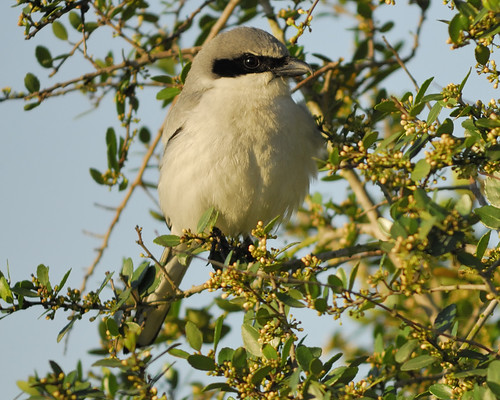tags: Loggerhead Shrike, Lanius ludovicianus, birds, mystery bird, bird ID quiz
[Mystery birds] Loggerhead Shrike, Lanius ludovicianus, photographed at Paul Rushing Park, Texas. [I will identify this bird for you tomorrow]
Image: Joseph Kennedy, 28 March 2009 [larger view].
Nikon D200, Kowa 883 telescope with tsn-pz camera eyepiece 1/350s f/8.0 at 1000.0mm iso400.
Please name at least one field mark that supports your identification.
Rick Wright, author of Aimophila Adventures and Managing Director of WINGS Birding Tours Worldwide, writes:
There's really nothing else that looks like a shrike. The black mask, hooked bill, and in our North American species, gray plumage rules out just about anything else. Northern Mockingbird is the hoary old "confusion species," but they really aren't that similar. A good quick distinction on distant perched birds (and visible in this photo, too) is the lack of "air" between the belly and the perch of a shrike; while mockingbirds sit high with tarsus extended, shrikes tend to hunker down such that the belly feathers nearly or entirely touch the perch, whether it's a wire or a twig.
The fact that this bird was photographed in Texas narrows the possibilities considerably. Northern Shrike is rare that far south, and in a view like this would show some wavy barring on the underparts, a pale base to the lower mandible, and a white semicircle under the eye. The earnest fellow depicted here is a Loggerhead Shrike, a species sadly declining over much of its range, and one that is essentially gone from the northeastern portions of its historical range.


Loggerhead Shrike.
The beak, with the little downturn on the very end, the black mark across the eyes and field marks.
The color is associated with immature Loggerhead Shrikes in my Peterson.
I know so little about North American birds that I won't bother trying to identify it, except that I'm pretty sure it's a shrike because of the slightly hooked upper bill and black mask.
I've realised that the black mask is a very common trait among the shrikes belonging to the genus Lanius. Makes me wonder if it's a basal feature that was present in the most recent common ancestor of all these shrikes.
Definitely a Loggerhead Shrike, but I'd say an adult, mainly b/c it lacks the fine barring, but also b/c the photo was taken in march, march, making it a but too early to see juveniles.